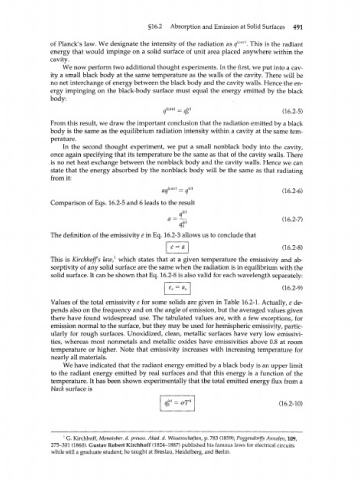Page 511 - Bird R.B. Transport phenomena
P. 511
§16.2 Absorption and Emission at Solid Surfaces 491
of Planck's law. We designate the intensity of the radiation as ^ (cav) . This is the radiant
energy that would impinge on a solid surface of unit area placed anywhere within the
cavity.
We now perform two additional thought experiments. In the first, we put into a cav-
ity a small black body at the same temperature as the walls of the cavity. There will be
no net interchange of energy between the black body and the cavity walls. Hence the en-
ergy impinging on the black-body surface must equal the energy emitted by the black
body:
qf (16.2-5)
From this result, we draw the important conclusion that the radiation emitted by a black
body is the same as the equilibrium radiation intensity within a cavity at the same tem-
perature.
In the second thought experiment, we put a small nonblack body into the cavity,
once again specifying that its temperature be the same as that of the cavity walls. There
is no net heat exchange between the nonblack body and the cavity walls. Hence we can
state that the energy absorbed by the nonblack body will be the same as that radiating
from it:
<wf (cav) = q {e) (16.2-6)
Comparison of Eqs. 16.2-5 and 6 leads to the result
The definition of the emissivity e in Eq. 16.2-3 allows us to conclude that
e = a (16.2-8)
This is Kirchhoffs law} which states that at a given temperature the emissivity and ab-
sorptivity of any solid surface are the same when the radiation is in equilibrium with the
solid surface. It can be shown that Eq. 16.2-8 is also valid for each wavelength separately:
(16.2-9)
Values of the total emissivity e for some solids are given in Table 16.2-1. Actually, e de-
pends also on the frequency and on the angle of emission, but the averaged values given
there have found widespread use. The tabulated values are, with a few exceptions, for
emission normal to the surface, but they may be used for hemispheric emissivity, partic-
ularly for rough surfaces. Unoxidized, clean, metallic surfaces have very low emissivi-
ties, whereas most nonmetals and metallic oxides have emissivities above 0.8 at room
temperature or higher. Note that emissivity increases with increasing temperature for
nearly all materials.
We have indicated that the radiant energy emitted by a black body is an upper limit
to the radiant energy emitted by real surfaces and that this energy is a function of the
temperature. It has been shown experimentally that the total emitted energy flux from a
black surface is
= o-T 4 (16.2-10)
1
G. Kirchhoff, Monatsber. d. preuss. Akad. d. Wissenschaften, p. 783 (1859); Poggendorffs Annalen, 109,
275-301 (1860). Gustav Robert Kirchhoff (1824-1887) published his famous laws for electrical circuits
while still a graduate student; he taught at Breslau, Heidelberg, and Berlin.

